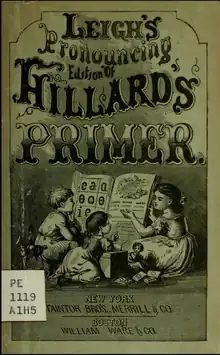
In the late 1800s in the United States, basal reading schemes introduced Pronouncing Orthography as a simplified version of traditional English orthography to help children learn to read more quickly and easily. It aimed to improve literacy education by eliminating the irregularities of conventional English orthography and adhering to the alphabetic principle, wherein every letter represented a specific sound.
The new orthography allowed children to read words by combining elementary sounds using phonics. It corrected the irregularities of traditional English orthography, making it easier for children to learn through using phonetics.
Dr Edwin Leigh invented Pronouncing Orthography after being inspired by another system called Fonotypy. William Torrey Harris promoted this method, which resulted in children learning to read about 12 months faster than with traditional English orthography.
Children who used this method became self-reliant, diligent, and happy learners. When they transitioned back to traditional English orthography, they were better at spelling and became logical and analytical thinkers instead of relying on learning by rote. Teachers who trialled the new method preferred it over the traditional method.
Etymology
Although Pronouncing Orthography was the formal name of the new orthography, publishers and educationists recognised that many people did not know what an orthography was; consequently, it was known by many different names, including: – Leigh Print, Leigh's Phonetic Type, Leigh's Phonetic Method, Leigh's Pronouncing Edition of... after Dr Edwin Leigh, who devised the new orthography. It was also sometimes known as Phonetic Orthography.
Background
The irregular nature of written English
Modern English orthography has developed over centuries using a version of the original Roman alphabet with spelling conventions formed from the haphazard historical amalgamation of words from different languages, including Greek, Latin & Anglo-Saxon; this has resulted in modern English orthography diverging considerably from the alphabetic principle, whereby the relationship between letters and speech sounds is not obviously apparent;[1] as such English is a complex language to become literate in, with English-speaking people having relatively poor literacy levels.[2]
Alexander John Ellis conducted an extensive study of the problems with English orthography, which he published in his treatise Plea for Phonetic Spelling, or the Necessity of Orthographic Reform, in 1848.[1] This was extensively cited as the philosophical foundation to justify the usage of the Pronouncing Orthography by the likes of William Torrey Harris.[3] Dr Edwin Leigh himself published a report quantifying the levels of illiteracy in the United States,[2] which he used to advocate for his Pronouncing Orthography.
Orthographic reform
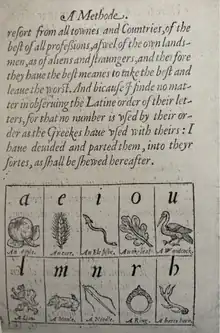
Attempts to remedy this issue have been ongoing without success since the Elizabethan era, when spelling conventions were becoming entrenched due to the printing revolution and the problems from an irregular orthography were being noticed; John Hart was the earliest known proponent of English orthographic reform during the 16th century.[4]
The main attempt at orthographic reform in the 19th century was published in 1844 by Isaac Pitman and Alexander John Ellis, who jointly developed Fonotypy as an exemplar of regularised English orthography. To demonstrate Fonotypy's efficacy and prove the case for orthographic reform, Fonotypy was used to teach children and illiterate adults in Britain and the United States of America; this culminated in a large-scale experiment in ten schools with 800 pupils in Waltham, Massachusetts, between 1852 & 1860.[5] The chairman of Waltham's school committee minuted the result: –
"It has been proved in repeated experiments that if a child, upon first learning letters, is taught the Phonetic Alphabet, and is confined to Phonetic books for the first 6–8 months of schooling, he will at the end of his first year's schooling read common print and spell in common spelling better than children ordinarily do, at the end of 4–5 years of schooling."...[Reverend Thomas Hill][7]
Interim teaching medium
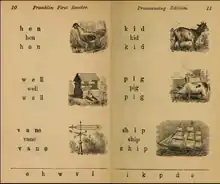
Although orthographic reformers had expected significant literacy improvements from phonetically pure orthography, they had not expected the children and newly literate adults to effortlessly transition to become literate in the standard, irregular orthography and have better spelling than people who had learnt conventionally.[8] So there emerged the realisation that orthographic reform may be unnecessary since a phonetically regular orthography could be used as an interim teaching medium to achieve the same goals as full-scale orthographic reform at a fraction of the cost.[9]
Leigh's insights
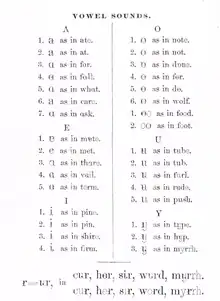
Experience of teaching with Fonotypy
Dr Edwin Leigh enthusiastically adopted Fonotypy as soon as it was published, so in 1946, he taught his daughter to read using Fonotypy; then, in 1949, he taught a class of fugitive slaves in Boston, which led to him to set up the Boston phonetic school in 1950 which he used as a springboard to introduce phonetic teaching into the schools of Somerville, Massachusetts. In 1959 he used Fonotypy in evening classes to teach illiterate adults in St Louis, Missouri, where he tried unsuccessfully to introduce Fonotypy into the public school system. His extensive experience of using Fonotypy allowed Leigh to understand its considerable strengths and shortcomings in teaching literacy.[10]
Criticisms
When Leigh failed to introduce Fonotypy into the schools of St Louis, Missouri, he described the main criticism he encountered: –
The causes of this ill success are many and obvious. Among them may be mentioned........ Fonotypy's departure from common orthography; changing the forms and outlines and spellings of English words, thus offending the eye and arousing the prejudices of the unlettered and the literary; apparently compelling the learner to master two languages, the phonetic and the English; requiring him to become familiar with the wrong spellings in order to learn the right, and to acquire an entirely new language in order to learn the common print. It was hard for men to believe that two languages (as it seemed to them) could be learned more easily than one, and the best way to learn to spell was first to spell wrong....[Dr Edwin Leigh][11]
Conclusions
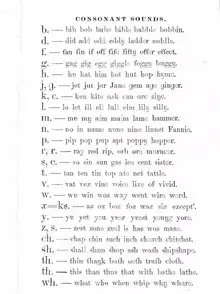
Leigh was aware that Fonotypy had been ambitiously designed for the purpose of orthographic reform, but he reasoned that only a simpler interim teaching orthography was needed to improve literacy. Fonotypy was designed to handle the speech sounds of European languages, whereas he only needed an English orthography. Fonotypy was designed to be easily hand-written, but Leigh only needed an orthography to be read. Fonotypy was also designed to be a longhand extension of phonetic shorthand, but Leigh did not need this feature to teach literacy. In addition, Leigh thought an interim teaching orthography was more likely to be adopted if it more closely resembled standard English orthography. Consequently, Leigh spent 20 years designing and refining his own interim teaching orthography.[12]
Design philosophy
Phonemic orthography
As with all phonemic orthographies, the principal objective of Leigh's new orthography was to enable children to correctly convert written words to speech regardless of whether the child was pre-acquainted with a particular word or not. A child can quickly and easily learn to read by knowing a consistent set of rules that convert letters to sounds. In contrast, standard English orthography's myriad rules and exceptions made this difficult.[13]
Familiarity with standard orthography
Secondly, Leigh wanted to avoid similar prejudice to that encountered against Fonotypy in St. Louis by making his new orthography familiar to the standard English orthography, so the Latin alphabet and spelling conventions were fully retained.[14] Instead, Leigh introduced phonetic regularity by making silent letters in words faint, so children were aware they should be ignored.[15] Leigh also subtly embellished other letters so children were explicitly aware of the sound made by those vocal letters.[16] In this way, Leigh hoped that the familiarity of the new orthography would persuade the detractors to accept the new orthography whilst children would still see through this veneer to read with phonetic clarity.

Elocution
The desire to speak eloquently and, in particular, to have correct Received Pronunciation was common in Britain and America during the 19th century, with the study of English orthoepy at its zenith. One feature of phonetic orthographies was that they converted written words into a single consistent form of pronunciation, which would often differ from the pronunciations used by people with different accents or regional dialects. In the 19th century, this feature of phonetic orthographies was considered a great benefit as children would learn new words in Received Pronunciation.[17] To this end, Leigh used the pronouncing dictionaries of John Walker & Benjamin Humphrey Smart, two of the leading orthoepists of the time to ensure his orthography resulted in correct pronunciation.[18] To emphasise this objective, Leigh called his new orthography Pronouncing Orthography.
Writing
Controversially, Leigh separated learning to read from learning to write; he described his position in his report to the Boston school committee: –
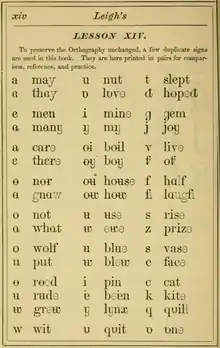
As to script, I stated my own conviction that it has no proper connection with learning to read and my desire to know from the writing master whether the habits formed by such writing of such words on the slate by so young learners will not have a bad influence upon their future handwriting and whether they will not acquire the art better at a later period and by exercises designed specially for the acquisition of good habits and skill in penmanship....[Dr Edwin Leigh][19]
Leigh also had no hand-written script versions of his letters because he relied on small, subtle embellishments to letters which were identifiable in print but unrecognisable in hand-written form. Leigh suggested children should learn to read using his orthography and then transition to standard English orthography, where they would learn to write.[20]
Alphabetic principle
In reality, Leigh's orthography did not lend itself to writing because of the asymmetrical application of the alphabetical principle. So every letter (grapheme) equated to a single sound (phoneme), allowing children to read with absolute certainty, but every sound (phoneme) equated to a multitude of possible letters (graphemes), meaning children would not know with certainty how to write an unfamiliar word.[21] This was necessary to keep words written in Pronouncing Orthography resembling those in conventional English orthography.
Teaching materials
Basal reading schemes
Reading was taught in the United States of America during the mid-19th century using popular basal reading schemes consisting of primers & readers. The majority of which were re-published in Leigh's Pronouncing Orthography, and are listed below: -[22]
| Author | Co-Author | Editor | Title | Year | View | Cite |
|---|---|---|---|---|---|---|
| G.S. Hillard | – | E. Leigh | Hillard's Primer. Edited in Pronouncing Orthography. | 1866 | Link | [23] |
| G.S. Hillard | – | E. Leigh | Leigh's Hillard's Second Reader, in Pronouncing Orthography | 1868 | – | [24] |
| G.S. Hillard | L.J. Campbell | E. Leigh | Franklin Primer or First Reader – Leigh's Pronouncing Edition | 1873 | Link | [25] |
| G.S. Hillard | L.J. Campbell | E. Leigh | Franklin Second Reader – Leigh's Pronouncing Edition | 1873 | Link | [26] |
| – | – | E. Leigh | The Graded First Reader. Edited in Pronouncing Orthography. | 1874 | [PDFs 1] | [27] |
| – | – | E. Leigh | The Graded Second Reader. Edited in [Leigh's] pronouncing orthography. | 1875 | [PDFs 2] | [28] |
| J.R. Edwards | – | E. Leigh | Analytical First Reader. Edited in Pronouncing Orthography. | 1864 | – | [29] |
| W.H. McGuffey | – | E. Leigh | Leigh's McGuffey's New Primary Reader in Pronouncing Orthography | 1864 | – | [30] |
| W.H. McGuffey | – | E. Leigh | Leigh's McGuffey's New Eclectic Primer in Pronouncing Orthography. | 1868 | – | [31] |
| L.B. Monroe | – | E. Leigh | The First Reader. Edited in Pronouncing Orthography by Edwin Leigh. | 1864 | [PDFs 3] | [32] |
| Y. Sargent | – | E. Leigh | Sargent's Standard Primer. Edited in Pronouncing Orthography. | 1866 | – | [34] |
| C.W. Sanders | – | E. Leigh | Leigh's Sanders' Union Reader, Number one, for Primary Schools and Families | 1868 | – | [35] |
| J.M. Watson | – | E. Leigh | Leigh's Watson's National School Primer in Pronouncing Orthography. | 1867 | – | [36] |
| J.M. Watson | – | E. Leigh | Independent First Reader. Edited in Pronouncing Orthography by Edwin Leigh. | 1867 | – | [38] |
PDFs
The Bible
In the mid-19th century, the bible was extensively read by children in schools; as such, Leigh translated two gospels into Pronouncing Orthography: –
- The Gospel According to Luke, reprinted in Pronouncing Orthography by Edwin Leigh; – Link[39]
- The Gospel According to John, reprinted in Pronouncing Orthography by Edwin Leigh; – Link[40]
Teaching usage
Leigh's Pronunciation Orthography became widely adopted in America in the late 1860s. The American public school system was publicly funded so was obliged to keep records, consequently, some public school boards published a detailed account of the usage of Pronouncing Orthography, in particular: – - St Louis, Missouri, Boston, and Washington.
St Louis, Missouri
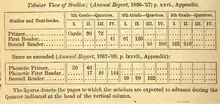
Dr Edwin Leigh was closely associated with the St Louis public school system, having served as a teacher for seven years.[41] In 1866, Leigh trialled his Pronouncing Orthography in Clay School, where Miss Helen Smith a recently qualified teacher carried out a controlled experiment, in which she taught two classes, one in pronouncing orthography and the other in standard orthography, allowing a like-for-like comparison. The conclusion was: -[42]
The class that used Leigh's Primer have a surprising degree of accuracy in distinguishing slight shades of different pronunciation, and can readily analyze any word into its elementary sounds, and spell it with its correct letters....[Superintendent Divoli][43]
William Torrey Harris had been the principal at Clay School during the trial and was then promoted to assistant superintendent of St Louis public schools.[43] Having seen the results of the new method at first-hand, he reported the marked improvement in children's articulation, spelling and the fact they learnt to read quicker using this method.[44]
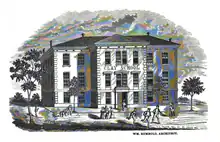
Based on this success, the St. Louis Board of Education sanctioned the city-wide adoption of the new phonetic system in the seventh grade from the 1867–1868 academic year.[45] Harris, who had been promoted to Superintendent, later reported on its spectacular success: –
The introduction of Leigh's Phonetic System into all of the primary departments was followed by better results than could have been anticipated … the sequel showed that pupils taught by the new system were far in advance of those taught the same length of time by the old plan....[Superintendent William Torrey Harris][46]
Throughout Harris's tenure as the Superintendent, up until 1879, he advocated for the superiority of Leigh's Pronouncing Orthography and the general advantage of phonetic teaching methods over word-based methods.[47][48][49][50][51][52][53][54] In 1873, Harris reported that the new method had spread to the main cities of America: – New York, Washington and Boston, as well as other cities in the West.[55] In 1877 he then published a full report on the method in response to ongoing enquiries from around the country.[56] Harris's successor, Edward Long, continued to use Leigh's method but was not a vocal advocate; in 1884, he stopped reporting on the methods and materials used to teach children literacy, so it is not known when Pronouncing Orthography stopped being used but was definitely used for at least 16 years in St Louis.[57]
Boston, Massachusetts

Dr Edwin Leigh also had close associations with the Boston school system. In the 1867–68 academic year, an order was passed by the Boston Board of Education authorising the introduction into the schools of Leigh's Phonic System of teaching the first steps of reading. The teachers in the Lincoln district had become acquainted with the method through their teacher training, so they immediately adopted the system and reported excellent results from this first use.[58]
John Philbrick was the Superintendent of Boston's public schools and recognised both the importance and the difficulty of initially learning to read.[59] Philbrick strongly advocated phonetics as the best method to teach literacy to children and considered Leigh's print an ingenious contrivance for facilitating the teaching of this method which was found to produce extraordinary results.[60] In 1870, Philbrick described his observations of the new method: –
Such results in teaching the first steps in reading I had never before witnessed in any school whatever, and they certainly afford strong evidence in favor of the new pronouncing type. I am happy to be able to put in this evidence in favor of the pronouncing type which Dr. Leigh has taken so much pains to perfect and make known....[Superintendent John Philbrick][61]
Philbrick continued to advocate for Leigh's Pronouncing Orthography until he relinquished his position as Superintendent to Samuel Elliott in the academic year 1877–78.[62][63][64][65][66][67][68] In his final Superintendent's report (1877), Philbrick published a closing report on the trial of Pronouncing Orthography. In 1879, Superintendent Samuel Elliott withdrew Leigh's Pronouncing Orthography because he supported the whole word method of teaching and objected to phonic teaching which he described as vox et praeterea nihil, a voice and nothing more, sound without meaning.[69] He also objected to the use of a secondary English orthography: –

If the child's home is one which has its books, the use of them will not prepare him for the primer which we put into his hands. It is unlike the nursery stories which he has been looking at, if not reading; it has a strange look, particularly on the inside, where characters he has never seen stare at him out of nearly every line... but the strangeness of any book at all is almost stupefying...[Superintendent Samuel Eliot][70][71]
At the time as Pronouncing Orthography was being dropped, a survey was carried out of the Boston teachers using Pronouncing Orthography, which clearly showed the majority of teachers preferred Pronouncing Orthography: -[72]
- Fifteen experienced teachers had used it for > 5 years and universally preferred using Pronouncing Orthography.
- Five teachers had recently started to use it for < 2 years and were uncertain, with one teacher opposed, one in favour, and three still undecided.
- Twelve teachers had not replied to the survey, but four years earlier, nine of those teachers had emphatically supported the orthography.
New York City
Leigh's Pronouncing Orthography was trialled in some New York schools in the academic year 1869–1870.[73] The following year the trial was hailed a success, and all New York schools were permitted to adopt the scheme if they so chose.[74] The Superintendent and his assistants continued to report on the success of Leigh's method in the subsequent years.[75][76] Unfortunately, in the academic year 1875–76, the Board of Education came under outside criticism for teaching too many "ornamental branches of study", after which Phonetic teaching and use of Pronouncing Orthography was dropped.[77]
Washington, District of Columbia
In 1871, The board of trustees of Washington public schools initiated a new course of study where Leigh's Pronouncing Orthography through Hillard's Primer & Second Readers were mandated along with Leigh's Sound Charts.[78]
Teaching methods
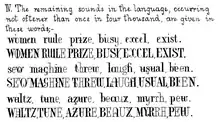
Leigh simply converted existing basal reading schemes to Pronouncing Orthography for expediency. The existing basal schemes were orientated towards various methods, including the phonetic and word methods or combinations of the two. Hence, he was agnostic about how teachers taught literacy as he presumed the benefits of phonetic tuition would be secured by using his orthography regardless of how it was taught.[79]
V. To retain the best features of the different modes of teaching to read and spell, now in use and most approved. This on the above plan, can be fully done, and yet all the advantages of the phonetic method secured to the teacher and learner....[Dr. Edwin Leigh][80]
Conversely, Leigh advised how Pronouncing Orthography could be taught when he segmented letter sounds into four categories: –
- Category I - Letter sounds most commonly uttered
- Category II - Letter sounds which occur once in every two hundred utterances
- Category III - Letter sounds which occur once in every thousand utterances
- Category IV - Letter sounds which occur once in every four thousand utterances
He suggested avoiding teaching category IV sounds using Pronouncing Orthography and instead waiting until the child has transitioned to conventional orthography. He also suggested prioritising Category I over Category II over Category III.[81]
Both Superintendents William Torrey Harris of St Louis and John Philbrick of Boston were adamant proponents of the Phonetic method. They considered Pronouncing Orthography as a useful tool in support of Phonetic teaching. New York, on the other hand allowed Pronouncing Orthography to be used with different methods, which Assistant Superintendent Calkins assessed in the academic year 1872–23, concluding that the Phonetic method was clearly superior.[82]
Advantages
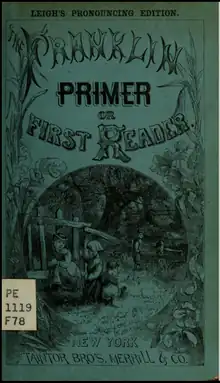
Over the period of its usage, Pronouncing Orthography was assessed in education journals and by superintendents in the American public school system, where the following advantages were identified: –
- Children learnt to read at least six to twelve months faster.[83]
- Children were better spellers after transitioning to conventional English orthography[84]
- Children were happier as they gained independence from teachers and became self-reliant[85]
- Children spoke with clear articulation and more eloquently after using Pronouncing Orthography[86]
- Teachers who had tried Pronouncing Orthography preferred it to conventional orthography.[72]
- Most importantly of all, children learnt to think logically.[87] William Torey Harris described this further: –
It is desirable that the child who is just commencing his education should have something consistent and logical ,methodical and philosophical to employ his mind upon rather than something without either analogy or system for these first impressions have the power to change and fix the whole bent of the mind...[Superintendent William Torrey Harris][88]
Awards

At the Vienna Exposition of 1873, Dr Edwin Leigh was awarded the Medal of Progress[89] as a recognition of merit for his invention of Pronouncing Orthography.[90]
Discontinuation
Pronouncing Orthography started to gradually fall into disuse in the later part of the 1870s and into the 1880s for several reasons: –
- There was a resurgence in the idea of teaching literacy using whole-word methods; in particular, Farnham's Sentence Method was published in 1881 but had already started to gain publicity through articles in the National Journal of Education.[91][92] This was exemplified in Boston, where Superintendent Philbrick, an advocate of the Phonetic method of teaching literacy, was replaced by Superintendent Eliot, an advocate of the whole-word method; consequently, Eliot discontinued the use of Pronouncing Orthography despite a majority of practising teachers wishing to retain it.[71]
- In New York, there was external pressure from outside the school system where people did not understand the whole idea of Pronouncing Orthography and considered it complex, expensive and an unnecessary ornamental branch of education. The New York Board of Education bowed to this pressure despite their previous acknowledgement of the superiority of Pronouncing Orthography.[77]
Articles in educational journals,[93][94][95] and reports from public school boards universally described Pronouncing Orthography as a practical success and popular in teaching. It was philosophical arguments which disregarded the efficacy of Pronouncing Orthography which resulted in its demise; these were articulated by Eliot: –
Here we fall into the error of putting the parts before the whole... but only to submit to the tyranny of their sounds....[Superintendent Samuel Eliot][70]
Citations
- 1 2 Alexander John Ellis 1848, pp. 1–195.
- 1 2 Barnard 1870, p. 144.
- ↑ St Louis Board of Education 1869, pp. 95–98.
- ↑ Pitman 1969, pp. 76–77, Four Centuries of Spelling and Alphabet Reform.
- ↑ Pitman 1969, pp. 79–88, Four Centuries of Spelling and Alphabet Reform.
- ↑ Withers 1874, p. 144.
- ↑ Hill 1853...cited in p.144 "the English Language Pronounced as Spelled" by George Withers [6]
- ↑ Pitman 1969, p. 84i, Four Centuries of Spelling and Alphabet Reform...The resemblance of the Fonotypic characters to roman characters – orginally intended to reduce adult opposition to the reform – paradoxically made the new reader's transition to the orthodox effortless...
- ↑ Pitman 1969, p. 84ii, Four Centuries of Spelling and Alphabet Reform...Though the intention and purpose was to reform the spelling of the whole community, it was soon discovered that Fonotypy was a dramatically effective aid in teaching children and illiterate adults to read (and to write) orthodox as well as Fonotypic spellings.
- ↑ Leigh 1864, p. 4, Edwin Leigh's Own Experiences.
- ↑ Leigh 1864, p. 3, Reasons Fonotypy has failed to succeed.
- ↑ Leigh 1864, pp. 2–3, Reasons Fonotypy failed to succeed and remediations.
- ↑ Stearns 1868, pp. 458–461, Dr Leigh's Phonetic Printing...The advantages claimed for the use of this type (Leigh's Pronouncing Orthography) in teaching to read are thus claimed: – 1st, the same letter has always the same sound; there is no confusion from contradictory teaching (as there is "do", "go", "on" etc.) which aids the memory and awakens an intelligent interest in the pupil. 2nd, The child can use the letters, they guide him with certainty to the right sound. He can help himself and be independent; this he loves and it does him good. 3rd, the constant presence in every word in the lesson of letters guiding to the right sounds, forms and fixes the habit of giving each sound correctly and distinctly.
- ↑ Leigh 1864, p. 6i, Main features of plan...II. To retain and print the established orthography in full.
- ↑ Leigh 1864, p. 6ii, Main features of plan...III To distinguish silent letters by a peculiar (or lighter faced) type of the same form as the rest, and just different (or light), enough to be distinct, while the form of the word, or word picture is retained uninjured.
- ↑ Leigh 1864, p. 6iii, Main features of plan...IV To distinguish the different sounds by modifications of the common letters, keeping ever the view the harmony of our English print; and to preserve, as much as possible, the present general appearance of each letter, word and page.
- ↑ Leigh 1864, p. 1, The main features of the plan...VI. To express, the deliberate, syllabic pronunciations and not the careless, and variously modified utterances of normal speech.
- ↑ Leigh 1864, p. 6, Main Features of Plan...VII. To follow our two great American orthoepists as far as they guide us; and (where they fail,) to consult Smart and Walker, especially in the case of unaccented syllables.
- ↑ Boston Board of Education 1877, p. 64, Edwin Leigh's Report...As to script, I stated my own conviction that it has no proper connection with learning to read and my desire to know from the writing master whether the habits formed by such writing of such words on the slate by so young learners will not have a bad influence upon their future handwriting and whether they will not acquire the art better at a later period and by exercises designed specially for the acquisition of good habits and skill in penmanship
- ↑ Soldan 1878, p. 1.
- ↑ Soldan 1878, p. 179.
- ↑ Venezky 1990, pp. 4–5, Reference Bibliography.
- ↑ Hillard 1866, p. 1.
- ↑ Hillard 1868.
- ↑ Campbell 1873i.
- ↑ Campbell & 1873ii.
- ↑ Leigh 1874.
- ↑ Leigh 1875.
- ↑ Edwards 1864.
- ↑ McGuffey 1864.
- ↑ McGuffey 1868.
- ↑ Monroe 1864.
- 1 2 3 Venezky 1990, p. 4.
- ↑ Sargent 1866...cited in pp.4–5 "American Primers, Guide to the Microfiche Collection" by Richard Venezky [33]
- ↑ Sanders 1868...cited in pp.4–5 "American Primers, Guide to the Microfiche Collection" by Richard Venezky [33]
- ↑ Watson 1867i...cited in pp.4–5 "American Primers, Guide to the Microfiche Collection" by Richard Venezky [33]
- ↑ Venezky 1990, p. 4-5.
- ↑ Watson & 1867ii...cited in pp.4–5 "American Primers, Guide to the Microfiche Collection" by Richard Venezky [37]
- ↑ St Luke 1877.
- ↑ St John 1873.
- ↑ St Louis Board of Education 1867, p. lxxii, List of teachers in the St Louis public schools and their residences August 29, 1859..."EDWIN LEIGH Assistant to the Principle of 66 Chesnut West of 11th Street"
- ↑ Leigh 1869, pp. 5–6.
- 1 2 Leigh 1869, p. 6...The class that used Leigh's Primer have a surprising degree of accuracy in distinguishing slight shades of different pronunciation, and can readily analyze any word into its elementary sounds, and spell it with its correct letters.
- ↑ St louis Board of Education 1867, pp. 56–57, Report of the Assistant Superintendent (William Torrey Harris)" The introduction of this system at the Clay School the use of a primer printed in modified type proved to be productive of the most satisfactory results The class that finished it made very rapid progress in learning to spell in the common orthography after they were transferred to the ordinary type in the First Reader But the best of all was the demonstration that the imperfections of articulation and the provincialisms of pronunciation current here can be completely eradicated by that thorough drill upon elementary sounds which is rendered necessary in teaching the Phonetic Primer Besides it was shown that this can all be done in less than the time required for completing the same text book in the ordinary type!"
- ↑ St Louis Board of Education 1867, p. 57, Report of the Assistant Superintendent (William Torrey Harris)It is therefore anticipated that the action of the Board by which the phonetic system has been adopted for the ensuing year in the seventh grade throughout the city will prove of great utility Before leaving the subject.
- ↑ St Louis Board of Education 1868, p. 97.
- ↑ St Louis Board of Education 1870, pp. 165–166.
- ↑ St Louis Board of Education 1871, pp. 182–184.
- ↑ St Louis Board of Education 1872, p. 151.
- ↑ St Louis Board of Education 1873, pp. 182–184.
- ↑ St Louis Board of Education 1875, p. cxc.
- ↑ St Louis Board of Education 1876, p. 1.
- ↑ St Louis Board of Education 1878, p. 197.
- ↑ St Louis Board of Education 1879, p. 262.
- ↑ St Louis Board of Education 1874, p. 53.
- ↑ St Louis Board of Education 1877, pp. 225–228.
- ↑ St Louis Board of Education 1883, p. 347.
- ↑ Boston Board of Education 1868, p. 141About a year ago, an order was passed by the Board authorizing the District Committees to introduce into the schools of their respective districts Leigh's Phonic System of teaching the first steps of reading. The Committee of the Lincoln District immediately availed themselves of this authority, in accordance with the desire of the master and of the teachers of the lowest classes of the Primary Schools, who had acquired a practical knowledge of this method in the Training School, where it has been taught for two years. The result of the year's experiment is considered very satisfactory. The pupils have made rapid progress in calling words at sight, and in accurate and distinct pronunciation.
- ↑ Boston Board of Education 1869, p. 170.
- ↑ Boston Board of Education 1869, p. 171, Superintendent's Report" The method which they recommended is substantially the same as that now practised by most of our Primary teachers. It is what we call the phonic method. It consists in teaching the pronunciation of words by means of the sounds of the individual letters and of certain combinations of two or more letters. The phonic 'print invented by Dr Leigh, is an ingenious contrivance for facilitating the teaching of this method. Leigh's phonic charts and readers have been used in the schools of several districts with marked success. In one school I found extraordinary results produced by a skilful application of the phonic method."
- ↑ Boston Board of Education 1870, p. 147.
- ↑ Boston Board of Education 1871, pp. 7–9.
- ↑ Boston Board of Education 1872, pp. 46–47.
- ↑ Boston Board of Education 1873, p. 84.
- ↑ Boston Board of Education 1874, p. 1.
- ↑ Boston Board of Education 1875, p. 77.
- ↑ Boston Board of Education 1876, p. 251.
- ↑ Boston Board of Education 1877, pp. 55–64.
- ↑ Boston Board of Education 1879, pp. 182–182 (overall report), 12–13 (Superintendent's Report).
- 1 2 Boston Board of Education 1879, p. 12...Here we fall into the error of putting the parts before the whole... but only to submit to the tyranny of their sounds.
- 1 2 Boston Board of Education 1879, pp. 181–182 (overall report), 11–12 (Superintendent's Report).
- 1 2 Leigh 1878, p. 195, The Boston Masters and Leigh Type.
- ↑ New York Board of Education 1870, pp. 150–151.
- ↑ New York Board of Education 1871, p. 217.
- ↑ New York Board of Education 1872, p. 1.
- ↑ New York Board of Education 1873, p. 1.
- 1 2 New York Board of Education 1876, pp. 123–124.
- ↑ Washington Board of Trustees 1871.
- ↑ Hillard 1866, p. 1-7, Teachers Notes.
- ↑ Leigh 1864, p. 6, Features of Plan.
- ↑ Leigh 1864, pp. 7–8, Segmentation of Letter Sounds.
- ↑ New York Board of Education 1873, p. 293-294...But the most successful plan of using this print appears to be that of presenting the word first as a sign of a spoken word then to teach the characters or letters used to represent the sounds of the spoken word to the sight then the spelling by letters. For instance the word fan may be spoken by the teacher and repeated by the pupils as the name of a familiar object then the word printed on the blackboard using Dr Leigh's form of a for the short sound then the sounds heard when the word is spoken are made separately next the form of the characters or letters that represent these sounds are taught afterward the word is sounded f a n then spelled by letter f-a-n fan.
- ↑ St Louis Board of Education 1877, p. 227, Superintendent's Report...(Pronouncing Orthography resulted in)...I. Gain in time a saving of one year out of the two years usually occupied in learning to call off easy words at sight.
- ↑ Harris 1878, p. 101...It has been demonstrated by actual experiment that children will learn to spell the English language far more correctly, and in one half the time by first learning to read in the phonetic way (using Pronouncing Orthography), which can be done in a few days. Dr. Stone of Boston proved this several times.
- ↑ Kriege 1876, p. 149...the pupil is enabled to find out the pronunciation of words himself, and is not dependent on the teacher after he has mastered the sign except for a little aid and encouragement. This gives a sense of self-reliance and gratification in discovery.
- ↑ Leigh 1869, p. 6b...But the best of all was the demonstration that the imperfections in articulation ... can be completely eradicated by that thorough drill upon elementary sounds which is rendered necessary in teaching the phonetic primer.
- ↑ St Louis Board of Education 1869, p. 98b, Superintendent's Report...With these considerations, the fact will not seem strange that pupils who are taught to read phonetically make better arithmetic and grammar scholars and are more wide awake and attentive and have finer discrimination – in short are more distinguished in those traits of mind that flow from analytic training.
- ↑ St Louis Board of Education 1877, pp. 225–227...It is desirable that the child who is just commencing his education should have something consistent and logical ,methodical and philosophical to employ his mind upon rather than something without either analogy or system for these first impressions have sometimes the power to change and fix the whole bent of the mind.
- ↑ Numismatics 1873.
- ↑ Boston Board of Education 1877, p. 57, Superintendent's Report...At the Vienna Exhibition the merit of his (Leigh's) invention was recognised by the award of the Medal of Progress, – the highest grade of medal bestowed.
- ↑ Farnham 1880i.
- ↑ Farnham & 1880ii.
- ↑ Weightman 1878.
- ↑ Stearns 1868.
- ↑ Lonfellow & Cragin 1876.
References
PAMPHLETS
- Leigh, Edwin (1864-01-01). "Pamphlet; – Pronouncing Orthography, Explained & Exemplified" (PDF). Library of Congress: 1–13.
- Leigh, Edwin (1869-01-01). "Pamphlet; – Pronouncing Orthography, results of its use in St louis". Library of Congress: 1–8.
JSTOR JOURNALS
- Leigh, Edwin (1865-08-01). "Pronouncing Orthography". The Massachusetts Teacher (1858–1871). 18 (8): 254–256. JSTOR 45026230 – via JSTOR.
- Leigh, Edwin (1878-09-26). "The Boston Masters and the Leigh Type". National Journal of Education. 8 (12): 195. JSTOR 44957525 – via JSTOR.
- Weightman, E (1878-10-03). "The Leigh type in Washington, for foreign-born and native children". National Journal of Education. 8 (13): 211. JSTOR 44957261 – via JSTOR.
- Stearns, Josiah (1868-12-01). "Dr. Leigh's Phonetic Printing". The Massachusetts Teacher (1858–1871). 21 (12): 458–461. JSTOR 45026673 – via JSTOR.
- Lonfellow, Mrs A.; Cragin, Miss L. (1876-02-19). "Dr. Leigh's Phonetic System". New England Journal of Education. 3 (8): 89. JSTOR 44765491 – via JSTOR.
- Kriege, Matilda (1876-10-07). "The Pronouncing Orthography and Froebel's System". New England Journal of Education. 4 (13): 149. JSTOR 44766389 – via JSTOR.
- Harris, W. (1878-02-14). "Advantages of the New Method or Spelling". National Journal of Education. 7 (7): 101. JSTOR 44960280 – via JSTOR.
- Soldan, Lewis; Leigh, Edwin (1878-09-19). "Pronouncing orthography, and script". National Journal of Education. 8 (11): 179. JSTOR 44957189 – via JSTOR.
- Farnham, George L. (1880-12-09). "Primary Reading; – The Sentence Method (Part I)". National Journal of Education. 12 (23): 392–394. JSTOR 44803446 – via JSTOR.
- Farnham, George L. (1880-12-16). "Primary Reading; – The Sentence Method (Part II)". National Journal of Education. 12 (24): 407–408. JSTOR 44803563 – via JSTOR.
- "Medals of the Vienna Exhibition". American Journal of Numismatics. 8 (2): 43. 1873-10-01. JSTOR 44803563 – via JSTOR.
BOOKS
- James Pitman; St John, John (1969). "Chapter 6 - Four centuries of spelling and alphabetic reform". Alphabets & Reading (1st ed.). Great Britain: Pitman. pp. 75–115. ISBN 0273433431.
- Downing, John (1967). "II - A Review of Previous Investigations (3) Field Trials or Demonstrations of Reformed Writing Systems". Evaluating the Initial Teaching Alphabet (1st ed.). Great Britain: Cassell. pp. 54–63.
- Alexander John Ellis (1848). Plea for Phonetic Spelling: or the Necessity of Orthographic Reform (2nd ed.). London: Fred Pitman.
- Withers, George (1874). The English Language Spelled as Pronounced. Germany: Verlag. ISBN 9783368810535.
- Farnham, George (1874). The sentence method of teaching reading, writing, and spelling : A manual for teachers. Syracuse, New York: C. W. Bardeen. ISBN 9783368810535.
PRIMERS
- Hillard, G. S. (1866). Leigh, Edwin (ed.). Hillard's Primer. Edited in Pronouncing Orthography. New York & Chicago: Taintor Brothers, Merrill and Company.
- Hillard, G. S. (1868). Leigh, Edwin (ed.). Leigh's Hillard's Second Reader, in Pronouncing Orthography. Boston: Brewer and Tileston.
- Hillard, G. S.; Campbell, L.J. (1873). Leigh, Edwin (ed.). Franklin Primer or First Reader – Leigh's Pronouncing Edition. New York: Taintor Brothers, Merrill, and Company.
- Hillard, G. S.; Campbell, L.J. (1873). Leigh, Edwin (ed.). Franklin Second Reader – Leigh's Pronouncing Edition. New York: Taintor Brothers, Merrill, and Company.
- Leigh, Edwin, ed. (1874). The Graded First Reader. Edited in Pronouncing Orthography (PDF). New York and Chicago: Ivison, Blakeman, Taylor and Company.
- Leigh, Edwin, ed. (1875). The Graded Second Reader. Edited in [Leigh's] pronouncing orthography (PDF). New York and Chicago: Ivison, Blakeman, Taylor and Company.
- Edwards, J. Russell (1864). Leigh, Edwin (ed.). Analytical First Reader. Edited in Pronouncing Orthography. New York and Chicago: Taintor Brothers, Merrill, and Company.
- McGuffey, William Holmes (1864). Leigh, Edwin (ed.). Leigh's McGuffey's New Primary Reader in Pronouncing Orthography. Cincinnati: Wilson, Hinkle and Company.
- McGuffey, William Holmes (1868). Leigh, Edwin (ed.). Leigh's McGuffey's New Eclectic Primer in Pronouncing Orthography. Cincinnati: Wilson, Hinkle and Company.
- Monroe, Lewis B. (1864). Leigh, Edwin (ed.). The First Reader. Edited in Pronouncing Orthography by Edwin Leigh. Philadelphia: Cowperthwait and Company.
- Sargent, Epes (1866). Leigh, Edwin (ed.). Sargent's Standard Primer. Edited in Pronouncing Orthography. Boston: John L. Shorey.
- Sanders, Charles W. (1868). Leigh, Edwin (ed.). Leigh's Sanders' Union Reader, Number one, for Primary Schools and Families. Ivison, Phinney, Blakeman.
- Watson., J. Madison (1867). Leigh, Edwin (ed.). Leigh's Watson's National School Primer in Pronouncing Orthography. New York and Chicago: A. S. Barnes and Company.
- Watson, J. Madison (1867). Leigh, Edwin (ed.). Independent First Reader. Containing the most valuable features of the word system, object lessons, and phonetics; and choice tales, fables, etc. in monosyllables. Edited in Pronouncing Orthography by Edwin Leigh. New York and Chicago: A. S. Barnes and Company.
SCHOOL COMMITTEE – BOSTON, MASSACHUSETTS
[Massachusetts public school system published detailed records of the initial adoption and later discontinuance of Leigh's Pronunciation Orthography between 1867 and 1879].
- School Committee of the City of Boston (Barnard Capen – Secretary); Philbrick, Superintendent John D. (1869-01-01). Annual Report of the School Committee of the City of Boston 1867 (Report). Boston: Rockwell and Churchill City Printers.
- School Committee of the City of Boston (Barnard Capen – Secretary); Philbrick, Superintendent John D. (1869-01-01). Annual Report of the School Committee of the City of Boston 1868 (Report). Boston: Rockwell and Churchill City Printers. p. 141.
- School Committee of the City of Boston (Barnard Capen – Secretary); Philbrick, Superintendent John D. (1870-01-01). Annual Report of the School Committee of the City of Boston 1869 (Report). Boston: Rockwell and Churchill City Printers. p. 171.
- School Committee of the City of Boston (Barnard Capen – Secretary); Philbrick, Superintendent John D. (1871-01-01). Annual Report of the School Committee for the City of Boston 1870 (Report). Boston: Rockwell and Churchill City Printers. p. 147.
- School Committee of the City of Boston (Barnard Capen – Secretary); Philbrick, Superintendent John D. (1872-01-01). Annual Report of the School Committee for the City of Boston 1871 (Report). Boston: Rockwell and Churchill City Printers. pp. 7–9.
- School Committee of the City of Boston (Barnard Capen – Secretary); Philbrick, Superintendent John D. (1873-01-01). Annual Report of the School Committee for the City of Boston 1872 (Report). Boston: Rockwell and Churchill City Printers. pp. 46–47, 94.
- School Committee of the City of Boston (Barnard Capen – Secretary); Philbrick, Superintendent John D. (1874-01-01). Annual Report of the School Committee of the City of Boston 1873 (Report). Boston: Rockwell and Churchill City Printers. p. 84.
- School Committee of the City of Boston (Barnard Capen – Secretary); Philbrick, Superintendent John D. (1875-01-01). Annual Report of the School Committee of the City of Boston 1874 (Report). Boston: Rockwell and Churchill City Printers.
- School Committee of the City of Boston (Barnard Capen – Secretary); Philbrick, Superintendent John D. (1876-01-01). Annual Report of the School Committee of the City of Boston 1875 (Report). Boston: Rockwell and Churchill City Printers. p. 77.
- School Committee of the City of Boston (Barnard Capen – Secretary); Philbrick, Superintendent John D. (1877-01-01). Annual Report of the School Committee of the City of Boston 1876 (Report). Boston: Rockwell and Churchill City Printers. pp. 251, 256.
- School Committee of the City of Boston (Geo. Smith – Secretary); Philbrick, Superintendent John D. (1878-01-01). Annual Report of the School Committee of the City of Boston 1877 (Report). Boston: Rockwell and Churchill City Printers. pp. 55–64.
Closing statement by Dr Edwin Leigh of progress made in the method
- School Committee of the City of Boston (George A. Smith – Secretary); Eliot, Superintendent Samuel (1879-01-01). Annual Report of the School Committee of the City of Boston 1878 (Report). Boston: Rockwell and Churchill City Printers. pp. 257–260.
Suggestion for the Course of Study for Primary Schools – Reading
- School Committee of the City of Boston (Phineas Bates – Secretary); Eliot, Superintendent Samuel (1880-01-01). Annual Report of the School Committee of the City of Boston 1879 (Report). Boston: Rockwell and Churchill City Printers. pp. 10–13.
Philosophical reasons for dis-continuing usage of Leigh's Pronunciation Orthography as espoused by new Superintendent Samuel Eliot
BOARD OF PUBLIC SCHOOLS – ST. LOUIS, MISSOURI
[Missouri public school system published detailed records of the initial adoption but reporting of Leigh's method lapsed after 17 years; it was known to be used between 1867 and 1883].
- Year 1 (1866–67); – Board of Public Schools; Assistant Superintendent William Torrey Harris (1868-01-01). Annual Report of the Board of Directors of the St. Louis Public Schools, for the Year Ending August 1st, 1867 (Report). Vol. 13. St. Louis: Missouri Democrat Book and Job Printing House. pp. 56–58.
Reading – In this connection also should be mentioned the phonetic modification of the alphabet by Dr Leigh. The introduction of this system at the Clay School the use of a primer printed in modified type proved to be productive of the most satisfactory results The class that finished it made very rapid progress in learning to spell in the common orthography after they were transferred to the ordinary type in the First Reader.
- Year 2 (1867–68); – Board of Public Schools; Superintendent William Torrey Harris (1869-01-01). Annual Report of the Board of Directors of the St. Louis Public Schools, for the Year Ending August 1st, 1868 (Report). Vol. 14. St. Louis: George Knapp & Co. Printers & Binders. p. 97.
during the past year there is little to be added to what was said in the report of last year The introduction of Leigh's Phonetic System into all of the primary departments was followed by better results than could have been anticipated The primary teachers exhibited a commendable degree of energy and persistency in mastering the best method of teaching it and the sequel showed that pupils taught by the new system were far in advance of those taught the same length of time by the old plan
- Year 3 (1868–69); – Board of Public Schools; Superintendent William Torrey Harris (1870-01-01). Annual Report of the Board of Directors of the St. Louis Public Schools, for the Year Ending August 1, 1869 (Report). Vol. 15. St. Louis: Missouri Democrat Book and Job Printing House. pp. 95–99.
Leigh's Phonetic System – A four page essay details the arguments for a rational phonetic method for learning to read
- Year 4 (1869–70); – Board of Public Schools; Soldan, Assistant Superintendent Louis; Superintendent William Torrey Harris (1871-01-01). Annual Report of the Board of Directors of the St. Louis Public Schools, for the Year Ending August 1, 1870 (Report). Vol. 16. St. Louis: Democrat Lithograph and Printing Company. pp. 25, 165–166.
The Phonetic system of teaching reading now used in all our primary grades is better adapted to the grasp of the childish understanding and gives the teacher so much more power over the youngest pupils that it will be safe to admit children of five years of age. Leigh's phonetic system of which I spoke at length last year continues to give the same satisfaction in this its fourth year of trial.
- Year 5 (1870–71); – Board of Public Schools; Superintendent William Torrey Harris (1872-01-01). Annual Report of the Board of Directors of the St. Louis Public Schools, for the Year Ending August 1, 1871 (Report). Vol. 17. St. Louis: Democrat Lithograph and Printing Company. pp. 182–184.
What I have said before regarding the success of Leigh's Phonetic or Pronouncing orthography I desire to repeat here with the additional force that new years of trial bring with them The time saved the clearness of enunciation the good spelling the strengthened intellect quickened by analytic training all these count in its favour as much as formerly.
- Year 6 (1871–72); – Board of Public Schools; Superintendent William Torrey Harris (1873-01-01). Annual Report of the Board of Directors of the St. Louis Public Schools, for the Year Ending August 1, 1872 (Report). Vol. 18. St. Louis: Democrat Lithograph and Printing Company. pp. 13, 25, 151.
Leigh's method of teaching reading continues to be as a success as in former years It saves half the time in the earliest years and secures better spelling and better standing of what is read It makes reading a pleasure to child and does much to influence him to read at home enabling the pupil to learn to read by analyzing words their elements and to combine them again from their elements
- Year 7 (1872–73); – Board of Public Schools; Superintendent William Torrey Harris (1874-01-01). Annual Report of the Board of Directors of the St. Louis Public Schools, for the Year Ending August 1, 1873 (Report). Vol. 19. St. Louis: Democrat Lithograph and Printing Company. pp. 182–184.
I am fully convinced that one half of the time usually spent in learning to read by the word method may be saved by the use of this system Its success in Burlington Peoria and other cities of the West in Washington New York and Boston go to prove that our enthusiasm over its use here is not the result of prejudice.
- Year 8 (1873–74); – Board of Public Schools; Soldan, Principal Louis (1875-01-01). Annual Report of the Board of Directors of the St. Louis Public Schools, for the Year Ending August 1, 1874 (Report). Vol. 20. St. Louis: Democrat Lithograph and Printing Company. p. 53.
Teacher Training in Leigh's Phonetics. Printing of Phonetic characters on the blackboard In addition to the above work the forms and sounds of the phonetic characters as found in Leigh's Phonetic Primer also teaching exercises upon this subject Methods of teaching reading.
- Year 9 (1874–75); – Board of Public Schools; Superintendent William Torrey Harris (1876-01-01). Annual Report of the Board of Directors of the St. Louis Public Schools, for the Year Ending August 1, 1875 (Report). Vol. 21. St. Louis: Democrat Lithograph and Printing Company. pp. cxc.
Text books used in the public schools, district schools, McGuffey's Leigh's Phonetic Primer, First Reader
- Year 10 (1875–76); – Board of Public Schools; Superintendent William Torrey Harris (1877-01-01). Annual Report of the Board of Directors of the St. Louis Public Schools, for the Year Ending August 1, 1876 (Report). Vol. 22. St. Louis: Slawson Printer.
- Year 11 (1876–77); – Board of Public Schools; Superintendent William Torrey Harris (1878-01-01). Annual Report of the Board of Directors of the St. Louis Public Schools, for the Year Ending August 1, 1877 (Report). Vol. 23. St. Louis: John J. Daly & Co. Printers. pp. 225–228.
Primary Reading – A full report on Dr Edwin Leigh's Phonetic System
- Year 12 (1877–78); – Board of Public Schools; Superintendent William Torrey Harris (1879-01-01). Annual Report of the Board of Directors of the St. Louis Public Schools, for the Year Ending August 1, 1878 (Report). Vol. 24. St. Louis: Democrat Lithograph and Printing Company. p. 197.
Text books used in the public schools, district schools, McGuffey's Leigh's Phonetic Primer, First Reader
- Year 13 (1878–79); – Board of Public Schools; Superintendent William Torrey Harris (1880-01-01). Annual Report of the Board of Directors of the St. Louis Public Schools, for the Year Ending August 1, 1879 (Report). Vol. 25. St. Louis: Democrat Lithograph and Printing Company. p. 262.
In the St Louis schools the primary instruction is considered to be of especial importance By the use of the phonetic system of learning to read invented by Dr Edwin Leigh at least one year is saved in learning to read The method uses a modified alphabet so formed that each character has one sound only Each letter in this alphabet resembles the corresponding letter of the ordinary alphabet so nearly that the general appearance of the words is preserved and a transition to the ordinary type is found quite easy after half a year's work in the new alphabet
- NOTE: - William Torrey Harris was replaced as Superintendent by Edward H. Long in 1880; the subsequent Superintendent's reports confirm continued usage of Leigh's phonetic method until 1883, after which the granularity of the reporting is reduced, so it is not known when Leigh's Pronouncing Orthography eventually stopped being used.
- Year 17 (1882–83); – Board of Public Schools, Superintendent Edward; Long (1884-01-01). Annual Report of the Board of Directors of the St. Louis Public Schools, for the Year Ending August 1, 1883 (Report). Vol. 30. St. Louis: Nixon Jones Printing Company. p. 347.
Text books used in the public schools, district schools, McGuffey's Leigh's Phonetic Primer, First Reader
BOARD OF EDUCATION – NEW YORK CITY & COUNTY
[New York public school system published detailed records of the initial adoption and later discontinuance of Leigh's Pronunciation Orthography between 1869 and 1876].
- Year 1 (1869–70); – Board of Education; Kiddle, Chief Superintendent Henry (1871-01-01). Twenty Ninth Annual Report of the Board of Education of the City And County of New York for the Year Ending 31st December 1870 (Report). Vol. 29. New York: New York Printing Company. pp. 150–151.
The system invented by Dr Edwin Leigh which under the authority of the Board has been tried in several of the schools during the past year is designed to obviate all these difficulties and perplexities affording as it does by slight modifications in the ordinary forms of the letters a separate sign for every sound in the language The results of the experiments already made I think to be favorable to the merits and success of the system the pupils not only learning to read in a shorter time but to read more distinctly and fluently and what is even more important making the acquisition in a thoughtful and logical manner so that their common sense is never shocked by inconsistencies nor their natural intelligence baffled by arbitrary contradictions I have found too by my own examinations that the children having learned to read Dr Leigh's print pass without any difficulty or additional instruction or practice to ordinary print the customary forms of the words being so little affected by the slightly modified letters employed. These experiments will be continued so as to embrace one other grade at the close of which I will communicate the results in a special report to the Board. It is proper also to state that the teachers who have had charge of the classes undergoing this instruction are, I believe without exception, pleased with the results thus far attained.
- Year 2 (1870–71); – Board of Education; Kiddle, Chief Superintendent Henry (1872-01-01). Thirtieth Annual Report of the Board of Education of the City And County of New York for the Year Ending 31st December 1871 (Report). Vol. 30. New York: New York Printing Company. p. 217.
The experiments in Dr Leigh's Pronouncing Orthography in progress at the time of the last report have been continued during the present year and the results have been very satisfactory. By recent action of your Board this method of teaching can now at the option of the Principals be used in all the schools and I trust that it will be more generally tried during the next year I feel convinced from the results already attained that it will prove the means of saving much valuable time both of teachers and pupils besides giving to the latter through their reading exercises far better mental training.
- Year 3 (1871–72); – Board of Education; Kiddle, Chief Superintendent Henry (1873-01-01). Thirty First Annual Report of the Board of Education of the City And County of New York for the Year Ending 31st December 1872 (Report). Vol. 31. New York: New York Printing Company. p. 201.
In this connection I will add that Dr Leigh's system of phonetic instruction continues to be used successfully in the schools where it was first introduced also that several other schools have commenced the use of books printed in his type I am satisfied that a proper use of this pronouncing orthography would be attended with beneficial results in all of our schools.
- Year 4 (1872–73); – Board of Education; Calkins, First Assistant Superintendent Norman (1874-01-01). Thirty Second Annual Report of the Board of Education of the City And County of New York for the Year Ending 31st December 1873 (Report). Vol. 32. New York: New York Printing Company. pp. 293–294.
I am still of the opinion that a proper use of this print during at least the first year of learning to read would facilitate the progress of the pupils in this branch So far as I have been able to ascertain those teachers who make themselves sufficiently familiar with the characters used in it to write them readily on the blackboard prefer them to the other form of letters during the first steps in teaching reading.
- Year 5 – 6; - No commentary on Leigh's Pronouncing Orthography.
- Year 7 (1875–76); – Board of Education; Kiddle, Superintendent Henry (1877-01-01). Thirty Fifth Annual Report of the Board of Education of the City And County of New York for the Year Ending 31st December 1876 (Report). Vol. 35. New York: New York Printing Company. pp. 123–124.
At the commencement of the year a change was however imperatively called for. It was the conviction of many that the course as then in operation was too complex and exacting and that it prescribed branches of study which consumed a large part of the time and efforts of the pupils without any adequate benefit The public mind had been influenced unfavorably toward our system in this respect the impression having become general that the cost of maintaining the public schools was unnecessarily increased by giving instruction in merely ornamental branches sometimes to the neglect of the more important ones The result of this agitation has been the entire revision of the course of instruction in the direction particularly of simplification and reduction and during the last four months the schools have been operating on the new basis…. In learning to read the children will not be permitted by the new course to waste their time in useless and impracticable phonetic lessons..
BOARD OF TRUSTEES of PUBLIC SCHOOLS – WASHINGTON
- (1870–71); -Board of Trustees of Public Schools (1871-01-01). Twenty-Fourth Report of the Board of Trustees of Public Schools of the City of Washington 1870–71 (Report). Vol. 24. Washington: City M Gill & Witherow Printers and Stereotypers. pp. 28, 228.
Leigh's Sound Charts and his edition of Hillard's Primer and Second Reader are generally and should be exclusively used.
- (1871–72); -Board of Trustees of Public Schools; Wilson, Superintendent J. Ormond (1872-01-01). Twenty-Fifth Report of the Board of Trustees of Public Schools of the City of Washington 1871–72 (Report). Vol. 25. Washington: City M Gill & Witherow Printers and Stereotypers. pp. 42–43.
In the New Course of Study Dr Leigh's Sound Charts and his edition of Hillard's Primer or First Reader and of the Second Reader are required to be used exclusively. This is an excellent feature, about ten years ago with many misgivings one of these charts was placed in the hands of a skilful Primary teacher for trial. There were doubts in regard to the method of teaching reading by sounds. Everyone was confident that the transition from the phonetic form of print to the common would prove to be a most serious objection, and it was moreover quite certain that the new system could be taught only by an expert who had been specially trained for the purpose. Contrary to all expectations, however, the first year's trial was by no means a failure, and the use of these charts by any of the teachers who desired it was authorized by the Board from that time to the present there has been a gradual increase in their use brought about entirely by the evident superiority of the system. Teachers of ordinary intelligence without any special instruction readily take up this method of teaching, and it has been found that pupils thus taught can thereby save six months of their valuable time that the reading of these pupils is decidedly superior and that the transition to the common form of print is without difficulty and the work of but a week I believe that in commencing to learn our language the phonetic system is the best and that the very ingenious form of presenting it invented by Dr Leigh is destined to come into general use.
- (1871–72); -Board of Trustees of Public Schools (1873-01-01). Twenty-SixthReport of the Board of Trustees of Public Schools of the City of Washington 1872–73 (Report). Vol. 26. Washington: City M Gill & Witherow Printers and Stereotypers. pp. 202, 207.
Leigh's Sound Charts and his edition of Hillard's Primer and Second Reader are generally and should be exclusively used.
- (1872–74); -Board of Trustees of Public Schools (1875-01-01). Twenty-Seventh Report of the Board of Trustees of Public Schools of the City of Washington 1873–74 (Report). Vol. 27. Washington: City M Gill & Witherow Printers and Stereotypers. p. 179.
Leigh's Sound Charts and his edition of Hillard's Primer and Second Reader are generally and should be exclusively used.
- Special Report - Barnard (Commissioner of Education), Henry (1870-06-13). Special Report of the Commissioner of Education on the Condition and Improvement of Public Schools in the District of Columbia (Report). Washington: Washington Government Printing Office. p. 144.
..but there are many adults as well as children whose school attendance has been prematurely abridged or entirely neglected and who cannot be gathered into the regular day school … and whose ability to read the language should be facilitated by textbooks and methods different from those in general use like those of Dr Leigh.
SCHOOL COMMITTEE – WALTHAM, MASSACHUSETTS
- School Committee of Waltham; Hill, Chairman, the Reverend Thomas (1853-06-01). Annual Report of the School Committee of Waltham 1853 (Report). Boston.
...It has been proved in repeated experiments that if a child, upon first learning letters, is taught the Phonetic Alphabet, and is confined to Phonetic books for the first 6–8 months of schooling, he will at the end of his first year's schooling read common print and spell in common spelling better than children ordinarily do, at the end of 4–5 years of schooling.
{{cite report}}: CS1 maint: multiple names: authors list (link)
GOSPELS
- Luke the Evangelist (1877). Leigh, Dr Edwin (ed.). Gospel According to St Luke, edited in pronouncing orthography (1st ed.). New York: Edwin Leigh.
- John the Apostle (1873). Leigh, Dr Edwin (ed.). Gospel According to St John, , edited in pronouncing orthography (1st ed.). New York: Edwin Leigh.
CATALOGUE
- Venezky, Richard L. (1990). Kesaris, Paul L.; Massant, Eric J.; Imholtz Jr, August A. (eds.). American Primers, Guide to the Microfiche Collection (PDF) (1st ed.). Bethesda, Maryland: University Publications of America. ISBN 1-55655-203-3.
THESIS
- Reeder, Rudolph (1900-05-01). The historical development of school readers and methods in teaching reading (Philosophy thesis). Columbia University.